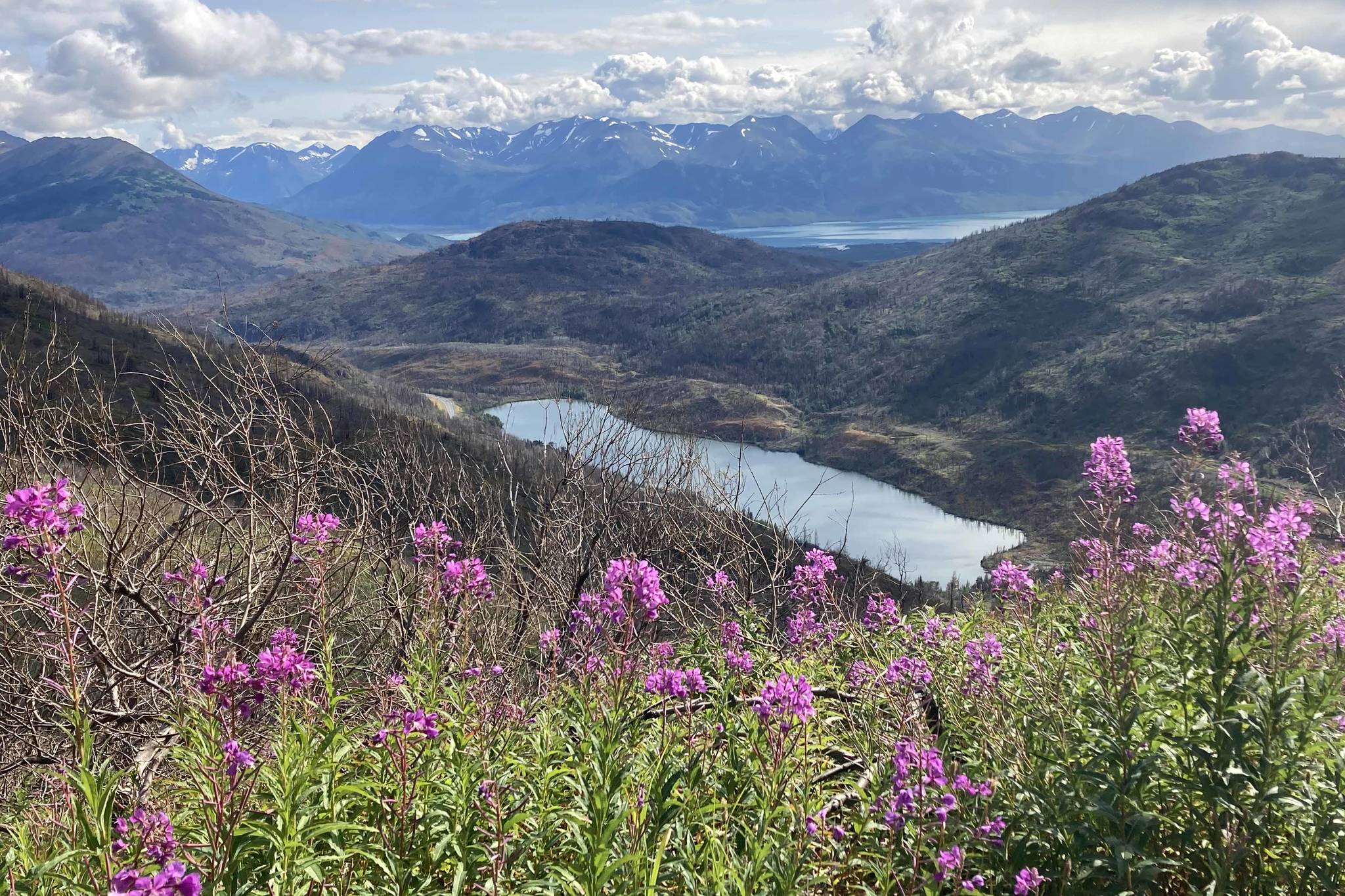By SANJA ZELEN
Kenai National Wildlife Refuge
It was March 16 of 2019 when I first heard of the ecological phenomenon known as a “super bloom,” an event that draws thousands to the desertscape of California.
Spurred by heavy winter rains and snow, a super bloom is a higher-than-normal growth of flowers in a natural area. As a result, flowers blanket hillsides, creating a patch of color visible from miles away.
When I came to Alaska from Oregon this past May to start my season working on trails for the Kenai National Wildlife Refuge, the wildflower season was just beginning due to the heavy, long-lasting snowpack the state had received this past winter.
Driving along Sterling Highway, fireweed covered the base of mountains in vibrant pinks. When I started work on the refuge’s Hansen Horse Trail, located in the backcountry, lupines dotted the side of the trail, their purples contrasting the ground, still wet and dark from recent rainfall. I was experiencing my own backcountry super bloom.
Seeing wildflower season erupt across the refuge, I could not help but think about the California super bloom of 2019.
The super bloom March 16 had people flocking to Northern and Central California’s fields and hillsides. The desertscape was painted in bright orange wild poppies.
I learned that California’s winter had been the 47th wettest on the state’s record, ending their drought for the first time since 2011. Painted lady butterflies began migrating north with the super bloom.
Hundreds of thousands of people sought photographic opportunities on the weekend of March 16 to 17. Social media blew up with the hashtag #PoppyShutdown as many areas closed due to the influx of visitors storming the hills. People put themselves at risk climbing steep hillsides just to capture an Instagram photo.
Alaska’s stunning wildflowers could easily attract photographers and tourists to the area. Most of the flower patches are accompanied by a mountain or lake backdrop. They could spur a #Fireweed or #Lupine shutdown, just as the poppies had. However, I realized that these flowers required true trekking to fully witness and enjoy.
The lupines I admired on the Hansen Horse Trail grew along a segment only accessible by a four-wheel drive road. The uneven footing and burnt trees added extra roadblocks to seeing the lupines.
Our campsite, 10 miles deep in the backcountry, was covered in fireweed. In a way, the lupine and fireweed were the consolation prize for the difficult trail work we were performing.
Fireweed’s growth patterns, in the bigger picture of the refuge’s recent fire history, are just as impressive — if not, more than — California’s rains bringing an end to the drought and an influx in wild poppies.
Fireweed got its name from its ability to grow back quickly after a fire event and its reliance on disturbed soil for growth. Its rhizomes, or underground stem system, and wind-dispersed seeds are the main reasons for its fire adaptability.
It was the first flower to grow back after the bombing of London in World War II and the eruption of Washington’s Mount St. Helens in 1980, as well as being abundant in oil spills and waste sites as noted by scientists with the United States Forest Service and National Resources Conservation Service.
The Swan Lake Fire of 2019, which burned large areas of the refuge, including most of the Hansen Horse Trail, has provided the perfect growth opportunity for fireweed.
Lupine is another wildflower that has been abundant on the trails I have explored. Lupine, like fireweed, is found in disturbed areas, such as those low in soil or revealed by retreating glaciers.
Lupine relies on fire, which controls the growth of surrounding plants that block sunlight from lupine. When hiking the Hansen Horse Trail, lupine was found growing among dead and burnt trees on an otherwise barren landscape.
Seeing the wildflower season come to fruition in Alaska has shown me firsthand the beneficial impacts that seemingly devastating ecological events can have on a landscape. Seeing only a few live trees over the 10-mile segment of the Hansen Horse Trail that I was working on week after week was disheartening.
Two years after the Swan Lake Fire there were still dead, burnt trees strewn about the trail. Seeing the impacts that the fire has had on fireweed and lupine made me realize and appreciate the importance of wildfires for regrowth.
Fires release nutrients into the soil and clear out dead organic material and invasive species that have not adapted to fires. Here on the Kenai, black spruce drop cones that require fire to melt the pitch and release the seeds inside the cone. Alder and willow resprout quickly after fire providing important woody browse for moose and snowshoe hare.
I was also interested to hear that in Northern states on the East Coast, the endangered Karner blue butterfly caterpillar relies on lupines for its food source, resulting in the caterpillar depending on fire as much as the lupines. Fire, for many species, is essential for regrowth and survival.
Being able to witness regrowth in areas that are still recovering from the Swan Lake Fire, without having to be surrounded by people, is something I have undoubtedly taken for granted. Seeing the fireweed flourish in the backcountry where few people trek made it feel like nature was giving me my own secret super bloom to enjoy.
Even those pink mountains just off the side of the road were free from visitors. Only the burnt trees were there to watch the flowers bloom, no selfie stick in sight.
Sanja Zelen is a Student Conservation Association Alaska Corps Member working on the Trails Crew this summer for the Kenai National Wildlife Refuge. She graduated from Willamette University last spring. Find more Refuge Notebook articles (1999–present) at https://www.fws.gov/refuge/Kenai/community/refuge_notebook.html

